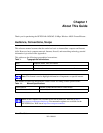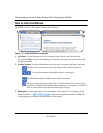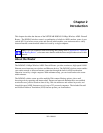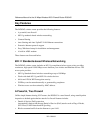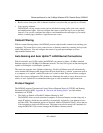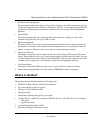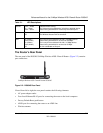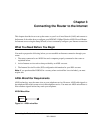
Reference Manual for the 54 Mbps Wireless ADSL Firewall Router DG834G
Introduction 2-3
202-10006-01
• Blocks access from your LAN to Internet locations or services that you specify as off-limits.
• Logs security incidents
The DG834G will log security events such as blocked incoming traffic, port scans, attacks,
and administrator logins. You can configure the router to email the log to you at specified
intervals. You can also configure the router to send immediate alert messages to your email
address or email pager whenever a significant event occurs.
Content Filtering
With its content filtering feature, the DG834G prevents objectionable content from reaching your
computers. The router allows you to control access to Internet content by screening for keywords
within Web addresses. You can configure the router to log and report attempts to access
objectionable Internet sites.
Auto Sensing and Auto Uplink™ LAN Ethernet Connections
With its internal 4-port 10/100 switch, the DG834G can connect to either a 10 Mbps standard
Ethernet network or a 100 Mbps Fast Ethernet network. The local LAN ports are autosensing and
capable of full-duplex or half-duplex operation.
The router incorporates Auto Uplink
TM
technology. Each local Ethernet port will automatically
sense whether the Ethernet cable plugged into the port should have a ‘normal’ connection such as
to a computer or an ‘uplink’ connection such as to a switch or hub. That port will then configure
itself to the correct configuration. This feature also eliminates the need to worry about crossover
cables, as Auto Uplink will accommodate either type of cable to make the right connection.
Protocol Support
The DG834G supports Transmission Control Protocol/Internet Protocol (TCP/IP) and Routing
Information Protocol (RIP). Appendix B, “Network and Routing Basics” provides further
information on TCP/IP.
• The Ability to Enable or Disable IP Address Sharing by NAT
The DG834G allows several networked computers to share an Internet account using only a
single IP address, which may be statically or dynamically assigned by your Internet service
provider (ISP). This technique, known as Network Address Translation (NAT), allows the use
of an inexpensive single-user ISP account. This feature can also be turned off completely for
using the DG834G if you want to manage the IP address scheme yourself.





